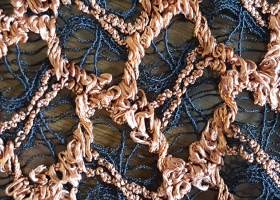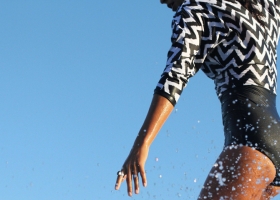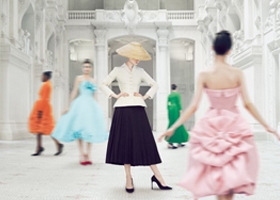
Intimoda Edit
Dress Codes Go Under the Microscope at Tenue Correcte Exigée
12 April 2017
With every new fashion season, just like in everyday life, it is difficult to escape the question of dress code.

Presented at the
museum Les Arts Décoratifs in Paris from the 12/01/2016 until the
04/23/2017, the exhibition invites us to revisit the scandals that were
responsible for the great shifts in fashion from the 19th century until
present day. Unique and unexpected, this huge retrospective invites us
to explore more than 400 items of clothing and accessories, portraits,
drawings and other little objects that have taken liberties or dared to
go against the daily dress code! But the dress code applies to more than
just clothing as it also reflects our moral positioning, women's
trousers, men's skirts, female tuxedos, mini skirts, baggy or blue jeans
and robe volante are known for the ways in which the challenged not
just clothing norms but also the norms of society itself. For this
reason, they were criticized as being too short, too long, too tight or
too loose and even banned when they first appeared. The exhibition,
designed by Constance Guisset, takes three major themes into
consideration: Dress Codes, Girl or Boy? and Provocative Excess.

DRESS CODES
The
exhibition takes examples from the Bible, sumptuary laws, royal
decrees, treatises on civility and good manners, fashion blogs and
makeover programs to illustrate not only that dress codes are not a
modern invention but the ways in which they have progressed over the
centuries.
In Judeo-Christian culture, clothing has always been
closely linked to the original sin as in the Garden of Eden, Adam and
Eve were naked until they were banished for committing the first sin.
From the Middle Ages to the 18th century, scholars repeated that our
clothing is an eternal reminder of the mistakes of Adam and Eve, and
therefore, must be as sober and discreet as possible. Today, we still
have to follow the dress codes for certain special events such as
baptisms, communions, marriages or for certain locations such as formal
dinners or receptions. Dress codes affect all of us, even royalty has
its own strict rules of decorum. Elisabeth Vigée-Lebrun's portrait of
Marie-Antoinette wearing a muslin negligée created such a scandal that
it had to be replaced with another painting of her in more conventional
attire. The situation isn't any easier for today's leaders, as countless
articles were written about the clothing choices of Michelle Obama for
example!

GIRL OR BOY?
A
mixing of male and female wardrobes has always been met with strong
reactions. The "androgynous look" became a big hit in the 1960s and is
still popular today but its roots can be found all the way back in
17th-century Britain where female aristocrats were fond of wearing male
clothing. In the 1920s and 1930s Gabrielle Chanel's unconstraining,
no-frills designs all played an important role in masculinizing the
female silhouette and in 1966 Yves Saint Laurent's female tuxedo made
trousers a fixed part of the female wardrobe. Of course, men have also
tried to adopt attitudes and garments regarded as feminine, but even
today some of these are still not accepted by mainstream society. Why
does a man wearing makeup cause such a stir? The men's skirt, revisited
by Jacques Esterel in the 1960s and then made famous by Jean Paul
Gaultier, is still not an accepted part of the male wardrobe right now.
The historic inferior status of women has created a fear of effeminacy,
which has ultimately slowed down the feminization of the male wardrobe.

PROVOCATIVE EXCESS
Every
fashion period ends up going to extremes, and these have resulted in a
long succession of "toos": too high (18th-century heels and hairstyles),
too short (the miniskirts of Paco Rabanne), too wide (the 1990s baggy
look), too transparent (think of the dress worn by Lady Diana for her
first appearance in 1981), "too figure-hugging" (a critique that has
existed since the middle ages!), too many colors, too dark, etc.
Crumpled, ripped and frayed clothing are seen as a "lack of decorum."
Fur and feathers have been causing scandals as early as the 18th century
when an awareness of animals being used for clothing began to emerge.
The exhibition ends with the runway shows that have sent shockwaves
through the fashion world from 1980 to 2015. In the early 80s, Yohji
Yamamoto and Rei Kawakubo challenged the codes of French couture with
their Japanese "unfinished" aesthetic. Alexander Mcqueen's Highland Rape
collection (1995-1996) revisited a narrative of trauma that lay dormant
in Scottish history. John Galliano's fall/winter 2000 collection for
Dior was inspired by Paris' homeless population, and more recently Rick
Owens' revealing Sphinx collection (SS15).
"How should we dress?"
This is the question that the exhibition tries to tackle, shedding new
light on the values and taboos revealed by our dress codes. By both
looking back at the past and forward to the future, it shows how moments
are being made in fashion history by today's designers.
Photo Credit: : Les Arts Décoratifs – Photographer. Luc Boegly
Related articles:
Copyright 2024. All rights reserved - Terms












